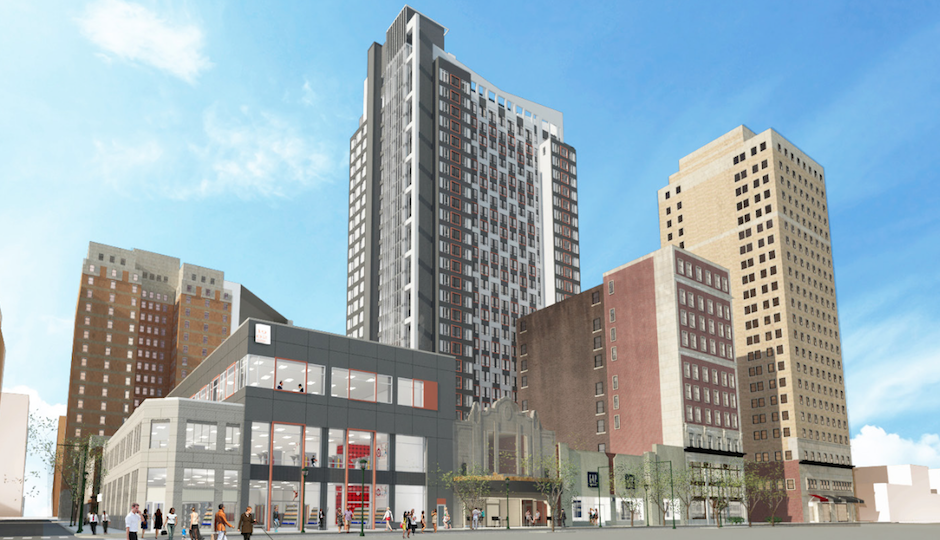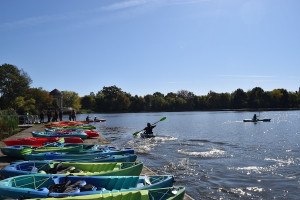Boyd Theatre Proposal Denied “as Presented” to Historical Commission Committee
Representatives for the redevelopment that is simply being called the Boyd Theatre project made their presentation to the Architectural Committee of the Historical Commission on Tuesday. It’s safe to say that the designs, only seen by the public thanks to the application to the commission posted on the city’s website, haven’t been well received since their release last week.
Inga Saffron was blunt and demanded more from the development team and the Historical Commission. The forum at the Skyscraper Page felt uninspired. On Tuesday, the Architectural Committee officially gave its collective thumbs down to the proposal.
The summer temps and packed crowd in room 578 in City Hall made for a stuffy atmosphere for a presentation. While reps from Eimer Architecture and Pearl Properties had information to give to the committee, they didn’t have enough in there to paint a clear picture of the proposal. Sure, they want to construct an apartment tower on the site on the Boyd’s amphitheater and bring in some office, retail and restaurant spaces, but what would it be made of and how would it interact with the street? How would the historic buildings (1900 Chestnut and the Boyd) be restored and integrated into the project? (The amphitheater, mind you, is still being demolished.) In the eyes of the committee, those questions weren’t sufficiently answered.
Committee chair Dominique Hawkins summed it up as such:
“I have a basic problem in that I don’t think that there is enough information on the drawings about the new construction for us to have a fully-formed idea of what you’re proposing, and that includes the materials as to what’s being proposed on Chestnut Street and the specifics of that.”
Ultimately, those unanswered questions led committee member John Cluver to move forward with a motion to deny to proposal as presented. The committee unanimously backed it. There was a round of applause from those in attendance.
There were a few sticking points for committee members throughout the presentation. For one, while the Boyd’s marquee will be restored to a design from a yet undetermined period of time from the theater’s history, the proposal calls for clear glass to replace the elaborate stained glass on the second floor overlooking Chestnut Street in what would eventually become a restaurant space. Committee members felt the colored glass was “integral” to the facade and would make for a “spectacular interior element” for future diners inside the space.
The committee was also “challenged” by the lack of specific details in the plans from Eimer, which provided little neighborhood context and specifics about use of materials in the new buildings. For example, the 3-story building in between 1900 Chestnut and the Boyd is a new construction with a dark facade. Eimer said it would be built using a masonry facade, but couldn’t elaborate any further as to whether it would be brick, some sort of paneling or something else. Committee member Nan Gutterman interjected: “You obviously have some idea. You’ve drawn something.”
The goal to activate Sansom Street with ground floor retail was welcomed by the committee, yet the design of the loading dock directly next to the retail space was dubbed “utilitarian.” At one point, a committee member mentioned it seemed like it was an “afterthought” in the design. It also takes up a large chunk of the historic vestibule from the Boyd Theatre–shortening it from 45-feet from Chestnut Street through to Sansom Street to 9-feet, according to the plan.
Howard Haas, President of the Friends of the Boyd, acknowledged the five other FoB members in attendance during the public comment period. He also thought the loading dock would be make for a “hostile streetscape” for the future redevelopment of the Rittenhouse Coffee Shop, which is part of another development project across the street. Haas also asked the terrazzo floor inside the Boyd to be saved and restored.
Jared Brey of PlanPhilly notes that the proposal will now go before the full Historical Commission in June. If you have some time, they also have the video from the meeting as well.



